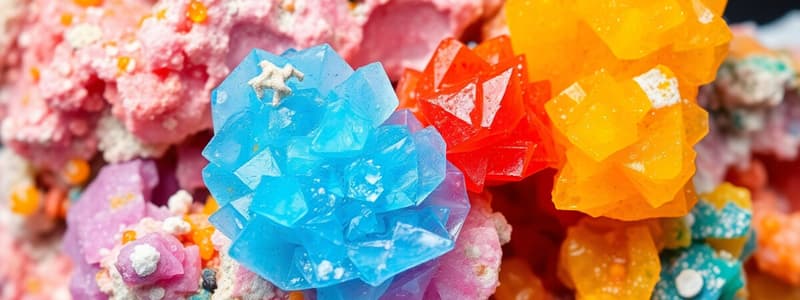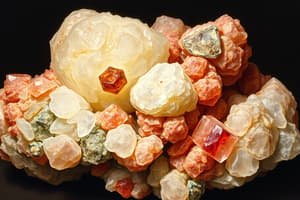Podcast
Questions and Answers
What defines a mineral according to its composition and structure?
What defines a mineral according to its composition and structure?
- A naturally occurring inorganic solid with a definite chemical composition (correct)
- A synthetic product created in a laboratory
- A material that can be divided by chemical means
- A substance that is formed from living organisms
Which method is used to determine the specific gravity of a mineral?
Which method is used to determine the specific gravity of a mineral?
- Using an electronic scale to weigh only the mineral
- Measuring the weight of the mineral in air and water (correct)
- Comparing the mineral's hardness with a reference mineral
- Calculating the mineral's density using its volume and mass
Which class of minerals contains sulfur and at least one other element?
Which class of minerals contains sulfur and at least one other element?
- Oxide minerals
- Sulfide minerals (correct)
- Silicate minerals
- Carbonate minerals
What is the primary concern associated with acid mine drainage?
What is the primary concern associated with acid mine drainage?
How does the crystalline structure of a mineral affect its properties?
How does the crystalline structure of a mineral affect its properties?
Which of the following describes a mineral's luster?
Which of the following describes a mineral's luster?
How do ore minerals differ from industrial minerals?
How do ore minerals differ from industrial minerals?
What is the importance of the arrangement of silicon and oxygen in silicate minerals?
What is the importance of the arrangement of silicon and oxygen in silicate minerals?
What distinguishes a mineral from a rock?
What distinguishes a mineral from a rock?
Why is examining multiple characteristics important in mineral identification?
Why is examining multiple characteristics important in mineral identification?
What health issue is associated with inhalation of mineral dust, particularly from silicates?
What health issue is associated with inhalation of mineral dust, particularly from silicates?
What defines the crystalline structure of a mineral?
What defines the crystalline structure of a mineral?
What is a feature of minerals that sets them apart from fossilized material?
What is a feature of minerals that sets them apart from fossilized material?
How does a miner distinguish between the hardness of different minerals?
How does a miner distinguish between the hardness of different minerals?
Which of the following best explains the environmental impact of mining affecting mercury levels in fish?
Which of the following best explains the environmental impact of mining affecting mercury levels in fish?
What is the significance of using specific gravity in mineral identification?
What is the significance of using specific gravity in mineral identification?
What is a defining characteristic of minerals that sets them apart from other substances?
What is a defining characteristic of minerals that sets them apart from other substances?
Which statement accurately describes the structure of minerals?
Which statement accurately describes the structure of minerals?
What does the specific gravity of a mineral indicate?
What does the specific gravity of a mineral indicate?
How can heavy metals in minerals become a health risk to humans?
How can heavy metals in minerals become a health risk to humans?
What mineral class do minerals that contain sulfur belong to?
What mineral class do minerals that contain sulfur belong to?
What is one way to identify a mineral based on its crystal structure?
What is one way to identify a mineral based on its crystal structure?
What is the primary use of Mohs’ scale in mineral identification?
What is the primary use of Mohs’ scale in mineral identification?
Which characteristic helps differentiate minerals from each other?
Which characteristic helps differentiate minerals from each other?
Flashcards are hidden until you start studying
Study Notes
Mineral Basics
- Mineral: A naturally occurring, solid, inorganic substance with a definite chemical composition and crystalline structure.
- Element: The fundamental unit of matter that cannot be divided by chemical means.
- Ion: An atom that has either lost or gained electrons to become electrically charged.
Mineral Classification
- Silicate: A class of minerals containing silicon and oxygen.
- Sulfide: A class of minerals that contain sulfur and at least one other element.
- Streak: The color of a fine powder form of a mineral.
- Luster: The way light interacts with the surface of a mineral.
- Crystal Habit: The characteristic shape of a single mineral crystal.
- Cleavage: The tendency of a mineral to break along flat surfaces.
- Fracture: The manner in which a mineral breaks other than along flat surfaces.
- Specific Gravity: The weight of a substance relative to an equal volume of water.
Key Concepts
- Silicate Tetrahedron: The fundamental building block of all silicate minerals, consisting of four oxygen atoms surrounding a silicon atom.
- Mohs' Scale: A ranking of minerals according to their resistance to scratching.
- Amphibole: A type of rock-forming silicate mineral, common in granite and continental rocks, but rare in oceanic crust.
Important Considerations
- Mineral Identification: Streak, luster, cleavage, and specific gravity are important characteristics to identify minerals.
- Mining Impacts: Mining practices can lead to environmental issues such as acid mine drainage and mercury poisoning.
- Health Risks: Grinding minerals into fine dust can pose health risks due to inhalation.
Gemstones
- Gemstone: A naturally occurring mineral with exceptional beauty, rarity, and durability.
- Ore Minerals: Minerals mined for their valuable metallic content.
- Industrial Minerals: Minerals used for their non-metallic properties in various industries.
Studying That Suits You
Use AI to generate personalized quizzes and flashcards to suit your learning preferences.





